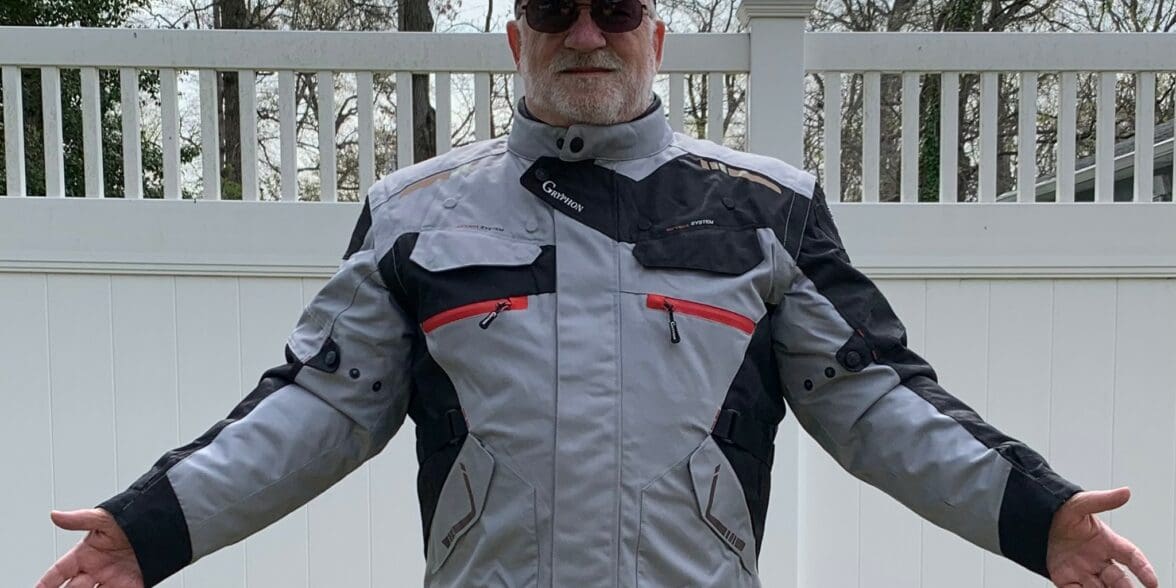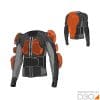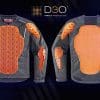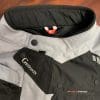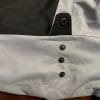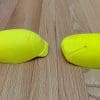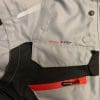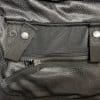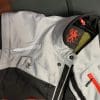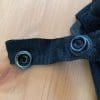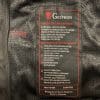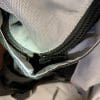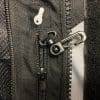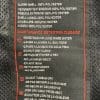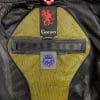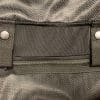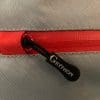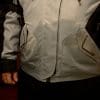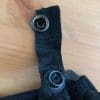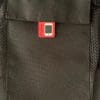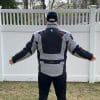I admit I was intrigued when I saw this jacket described as a four-season garment. As a year-round commuter, I’ve been wearing three-season jackets for years. In the colder months (10-40F), I plug in an electric jacket liner and gloves for the winter commute. In the summer, I’d rather shed the off-season layers, open the vents and be warm.
For the really hot, humid days of the Mid-Atlantic when the temperature and humidity both top 90%, I’ll even take off the jacket occasionally for the outbound commute at the end of the day. The theory is that if I’m too hot in a heavy jacket, I’ll think more about how hot I am instead of riding safely. Otherwise, I’m an ATGATT type in one of the busiest commuting regions in the States, where type-A, entitled drivers pay little attention to their fellow traffickers.
But this jacket arrived in April. How was I going to test its all-seasons claim in the standard six-week review period? Right after it arrived, the temperature dropped to 37F, so I shrugged into all three layers for the inbound commute.
Over the 16 mostly highway miles, only my fingertips got cold. The warm insulating puffer layer has a wind flap under the zipper and a nice high collar that keeps out the windchill.
See related: Gryphon Moto Vancouver Jacket Review
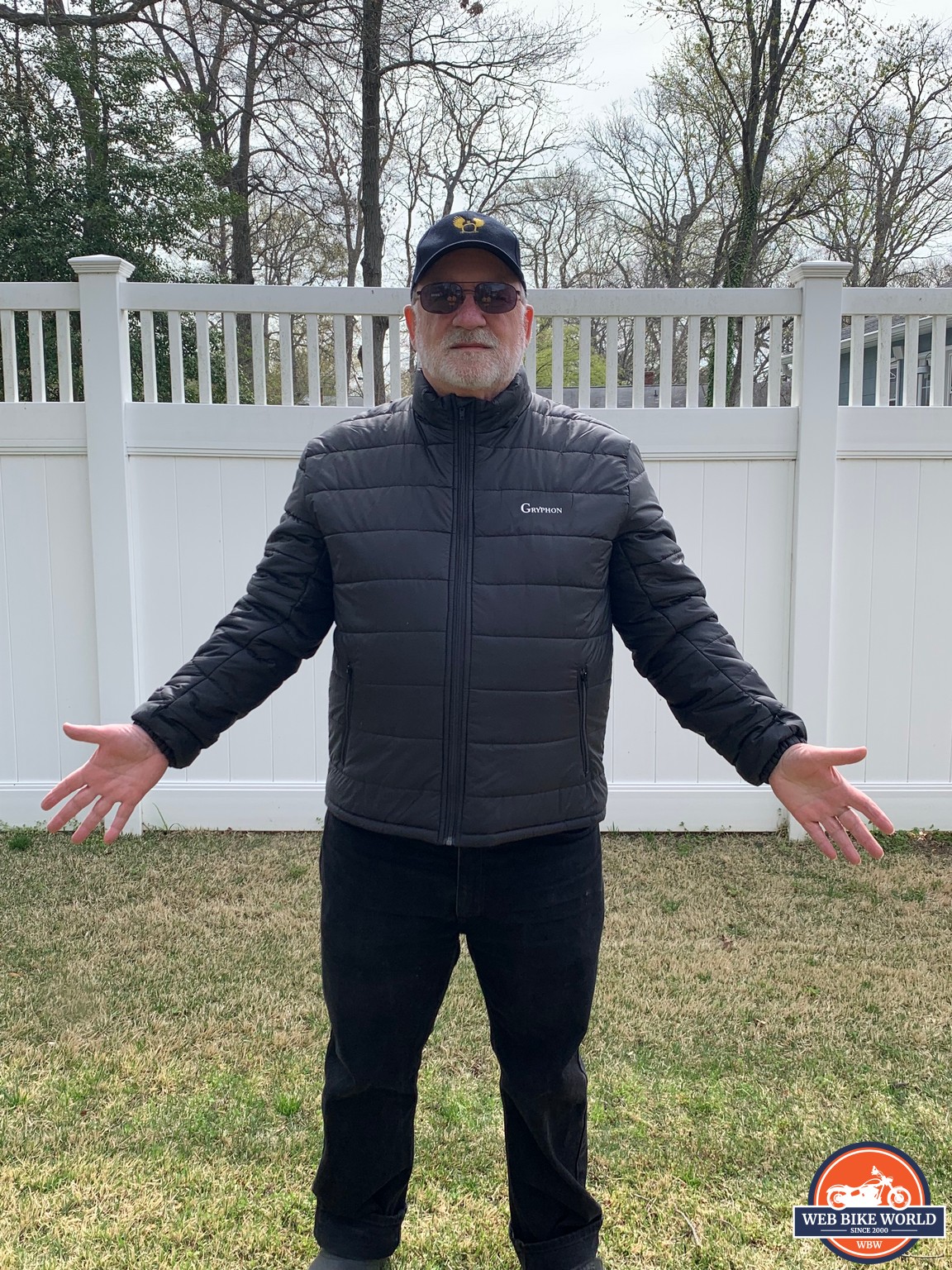
A few short weeks later in May, the temperature rose to 91F on the outbound ride home. I shed the two inner layers, unzipped the front and rear vents, opened the underarm zippers an inch or two, and loosened the wrist closures. That combination did the trick, allowing plenty of air to circulate inside the now looser fitting Frontier. So as far as I was able to test the jacket’s four-seasonality in the Mid-Atlantic springtime, the jacket performed as claimed.
Storage
Storage is one of this textile jacket’s strongest assets; its three layers contain a remarkable number of pockets. I had to count twice to make sure that the number of fifteen is correct. Starting with the outer layer, there are two chest pockets with horizontal water resistant zippers—the ends of the zippers go under a little pocket to keep them dry.
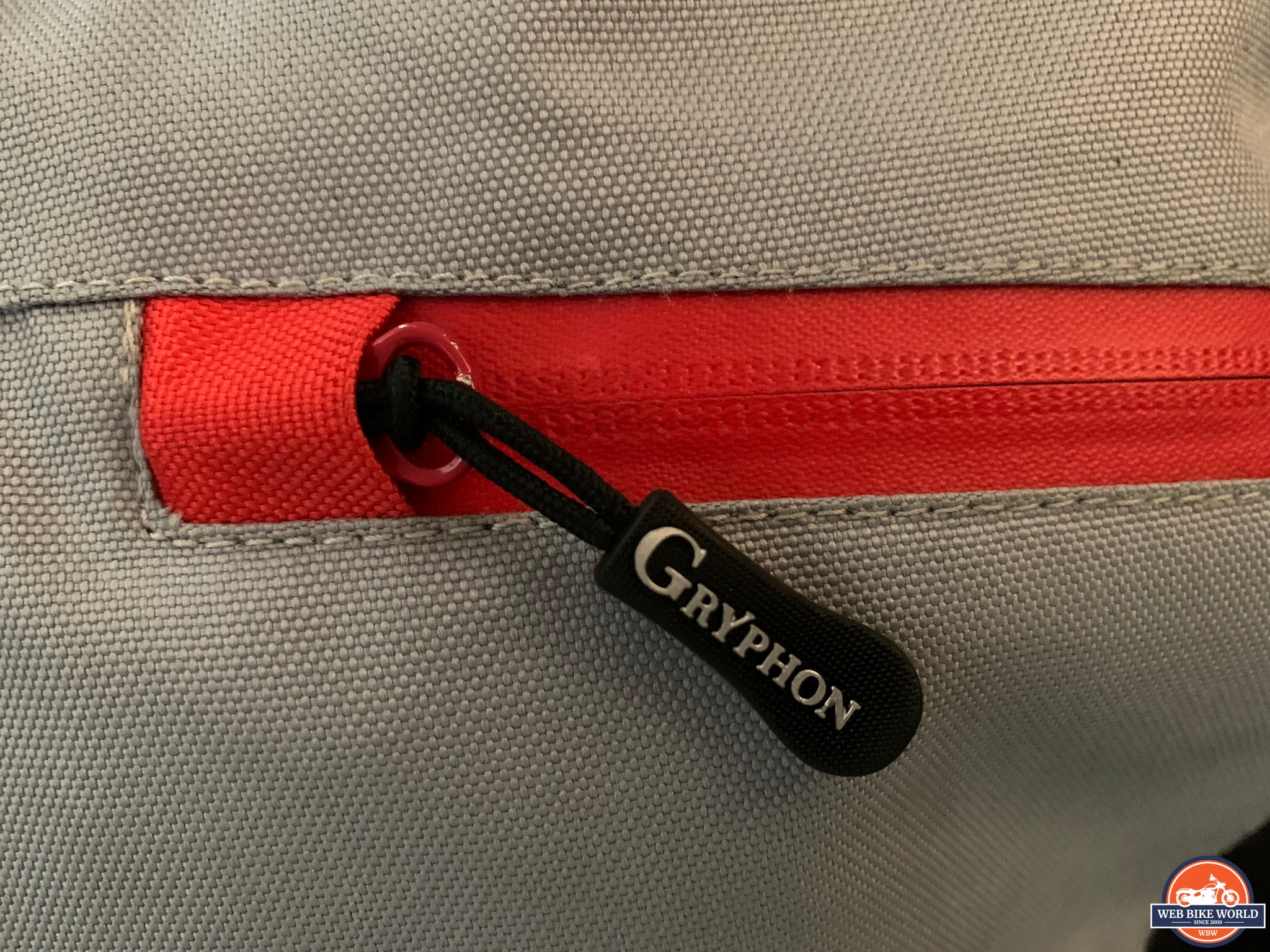
The large handwarmer pockets have foldover tops fastened with hook and loop (H&L) strips for a nice waterproof seal.
There’s a wide tabbed butt pocket on the back that can store the waterproof layer when not in use.
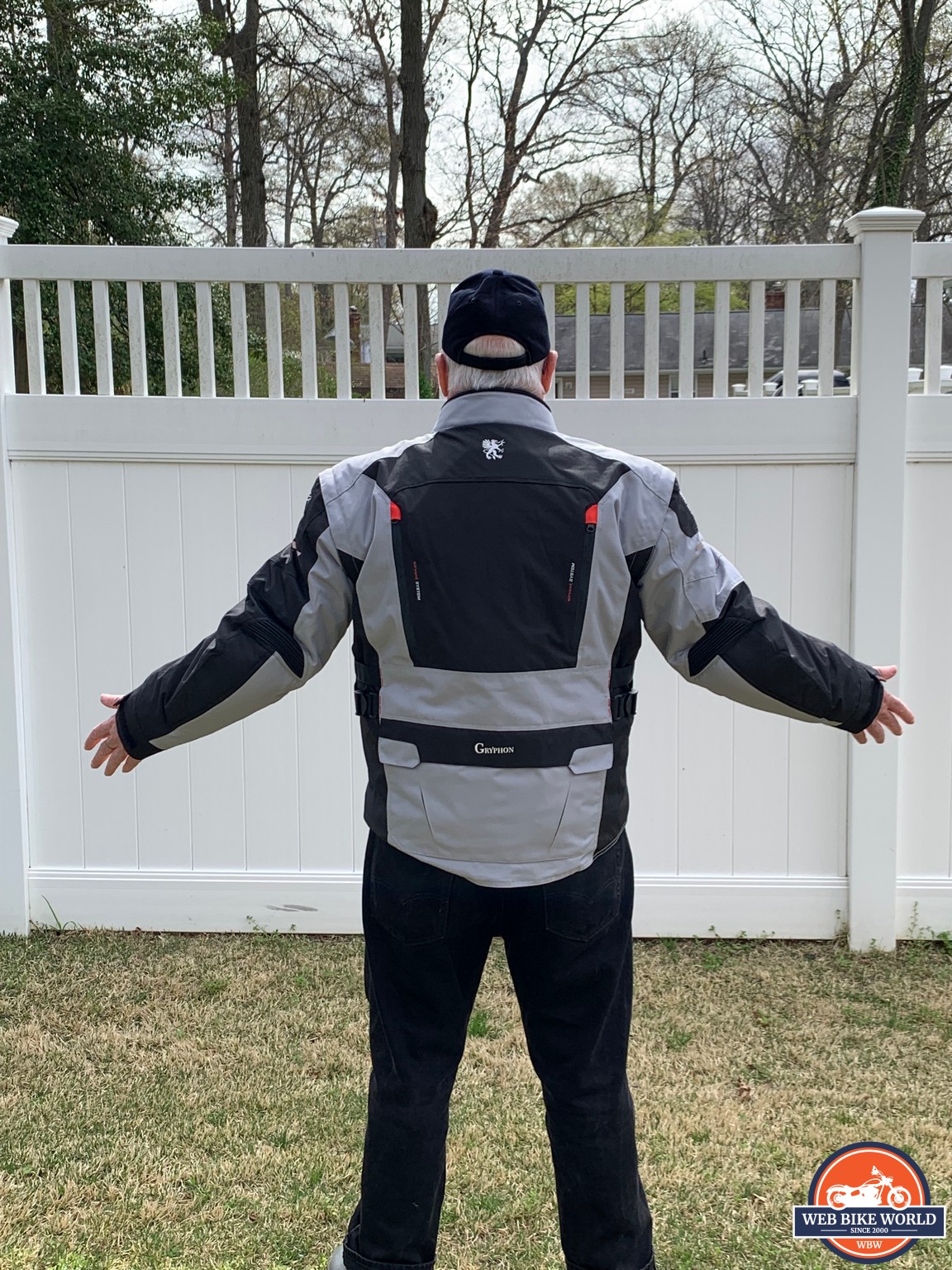
Oddly, the back pocket has external diagonal gussets not matched by the inside liner. Inside, there’s a waterproof phone pocket on the right breast and two pockets on the left; one fastened with H&Land one with a zipper.
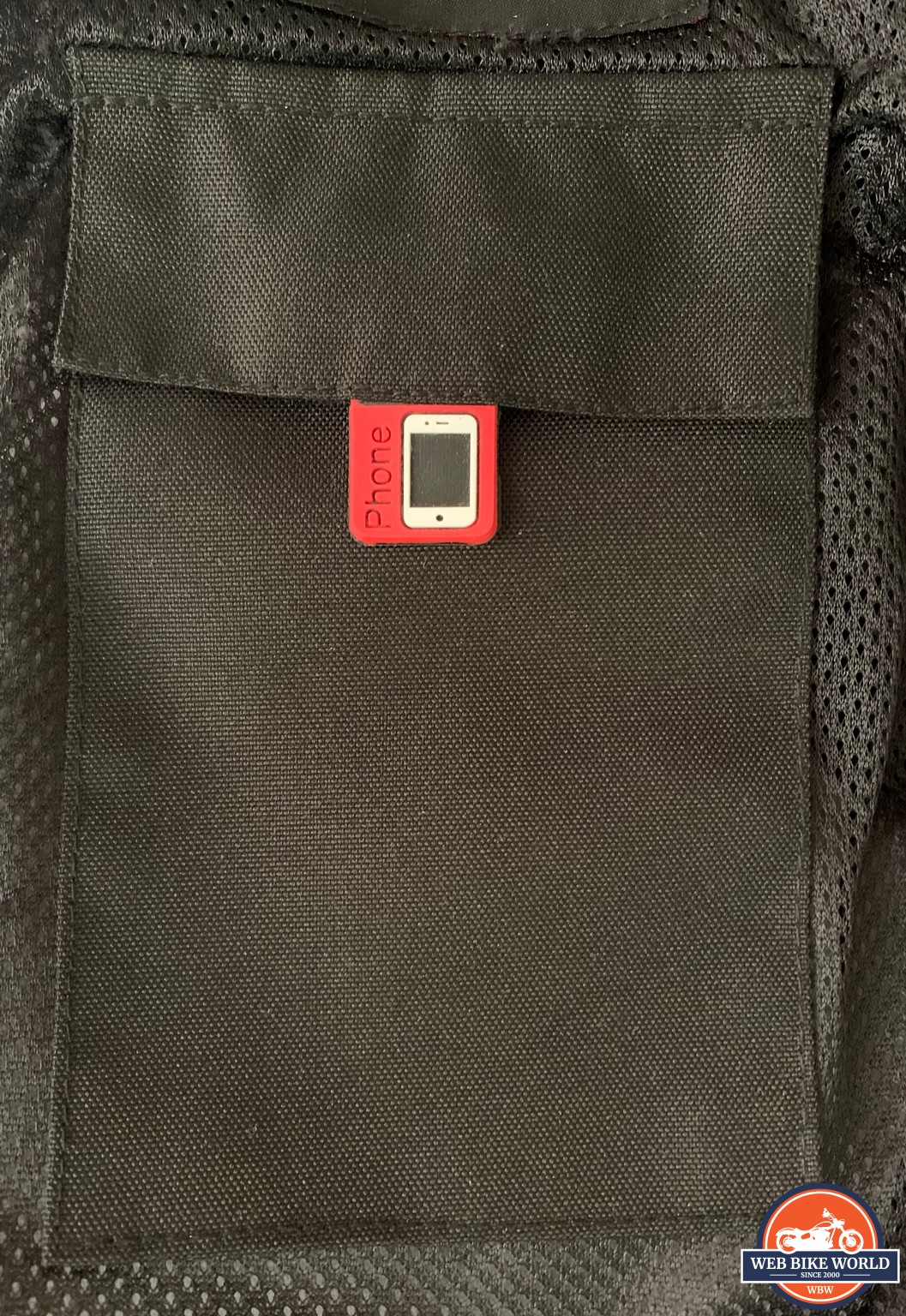
The zippered pocket on the left breast has a small clip for keys: another thoughtful feature.
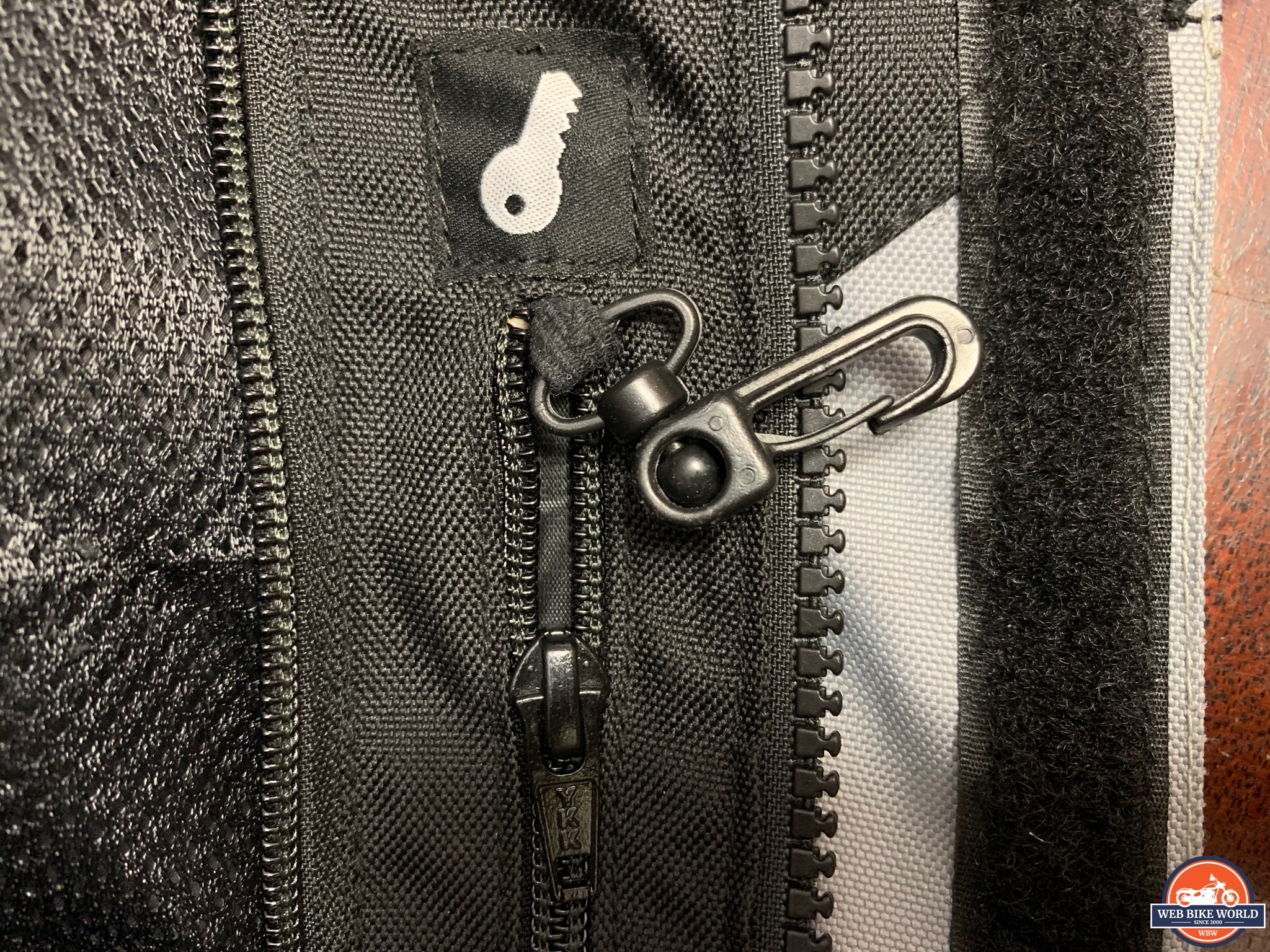
The waterproof Reissa layer has two outer pockets fastened with folded-over H&L, complemented with an inner left hip pocket that’s also H&L sealed. The puffer layer has two outer diagonal handwarmer pockets and two inner pockets; one is waterproofed for a phone.
Waterproofing
Right after I took the first round of photos, I donned the Reissa breathable waterproof layer by itself and spent four hours power washing my son’s house and sheds. Even with a 1,900-psi spray bouncing hard off the siding just a few inches away, nary a drop penetrated the lined layer. That was impressive, and it made what happened next pretty surprising.
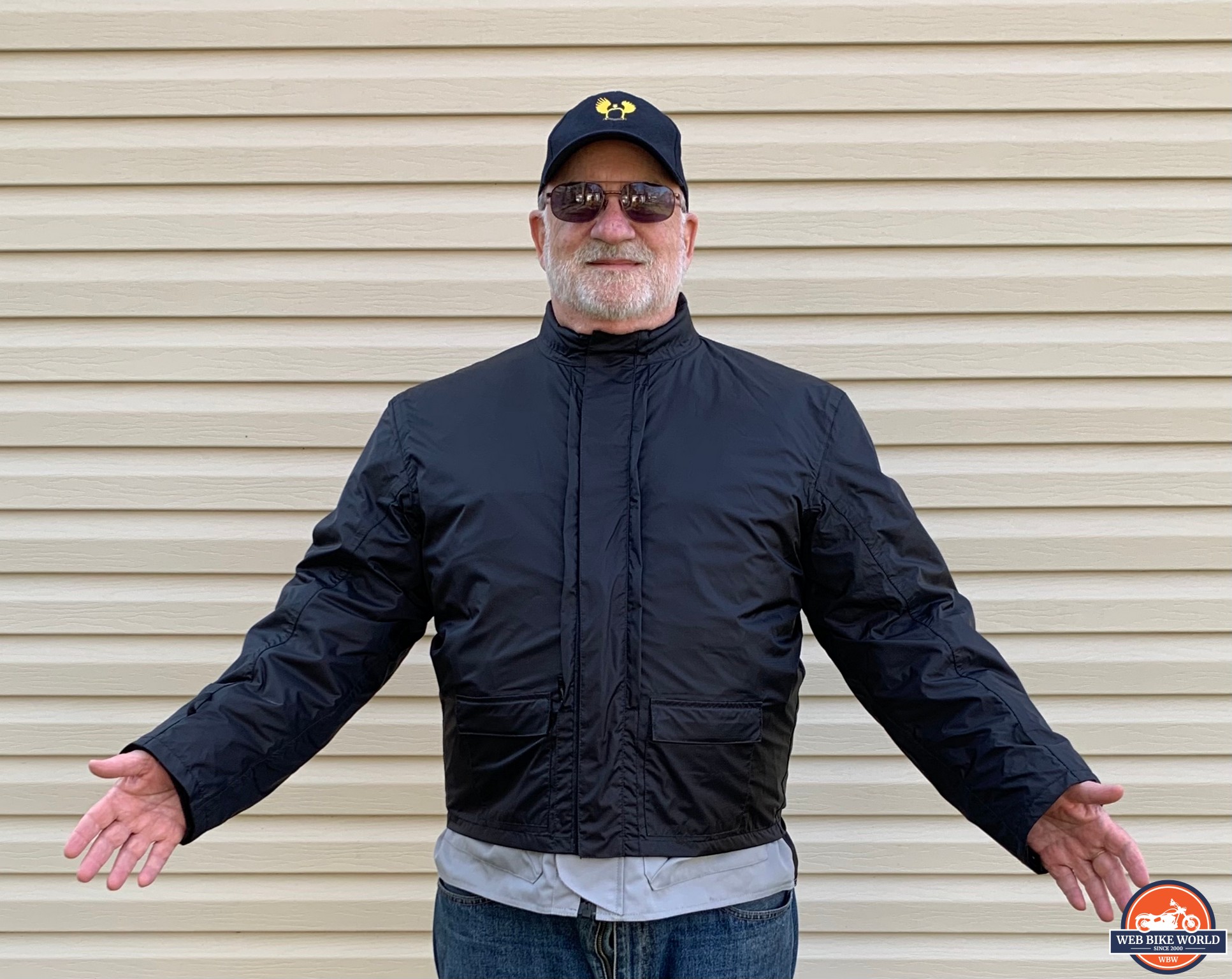
A fortnight later, I donned the waterproof layer over the textile layer and rode around for about an hour in a medium-to-heavy rain doing errands. I expected some water would get in down the neck, which has a nice loose fit; however, just the right amount of puffy fill in the high collar made for a dry, comfortable seal.
Unsurprisingly, the lower edge of the textile layer was wet all around, as expected from the shortness of the waterproof layer when worn on top. However, I found that the rainwater wicked pretty far up under the belly of the jacket and up the arms as well. I had a wet spot the size of an egg on my t-shirt. This was unexpected, and if I’d been riding in a cold rain for any amount of time, I would have been pretty uncomfortable.
The waterproof Riessa layer lacks wrist closures, so the rider is reliant on the textile layer wrist H&L closures underneath it to seal the wrists.
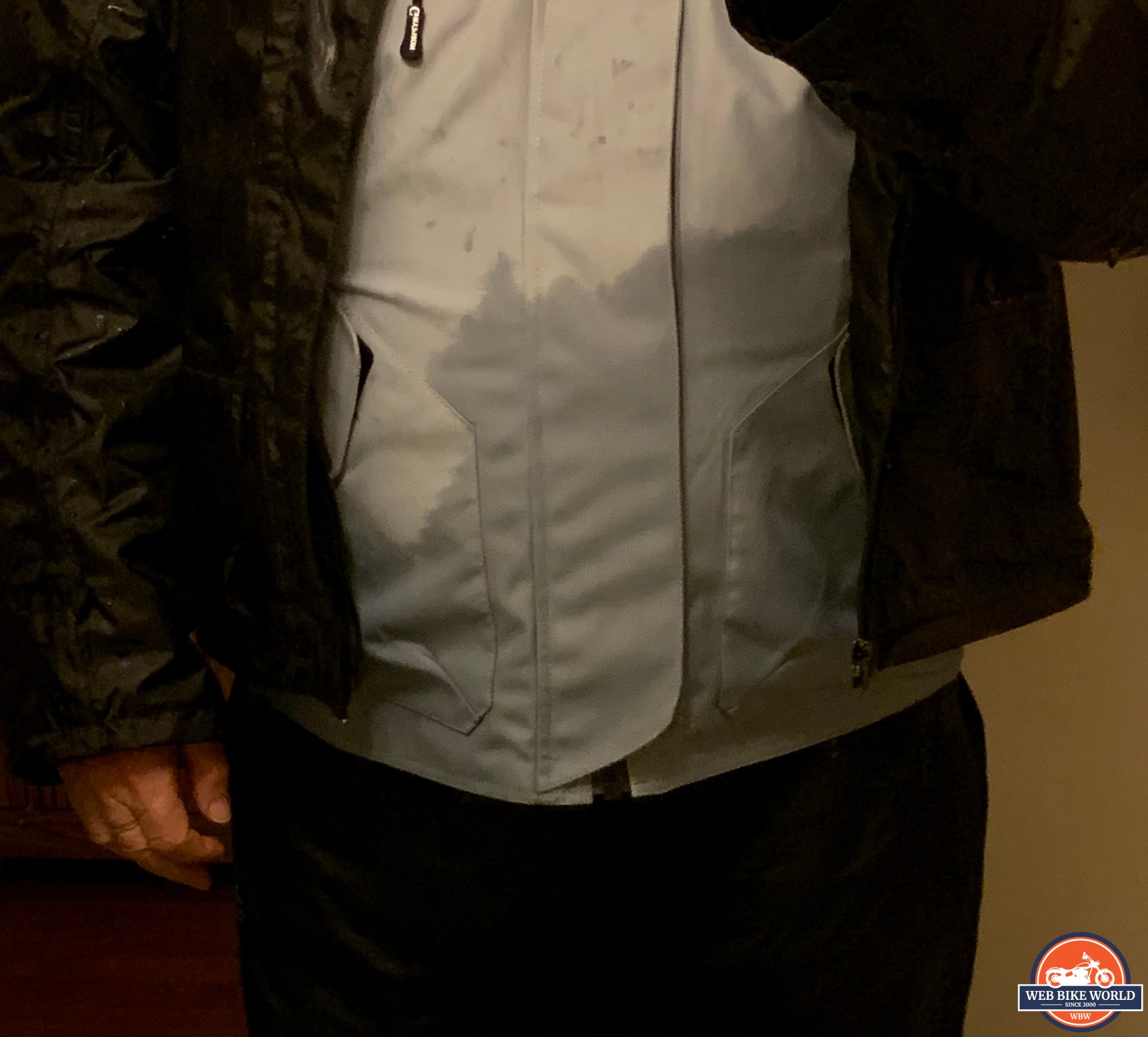
Next time I ride in the rain if it’s not too hot, I’ll try the rain layer underneath the textile layer to see how that works and if it keeps me drier. The two ends of the arm zippers leave a hole at the bottom that’s covered only by a wind flap. Putting the Riessa layer inside the textile outer jacket might prevent water from getting into a rider’s underarm through this hole during a long ride.
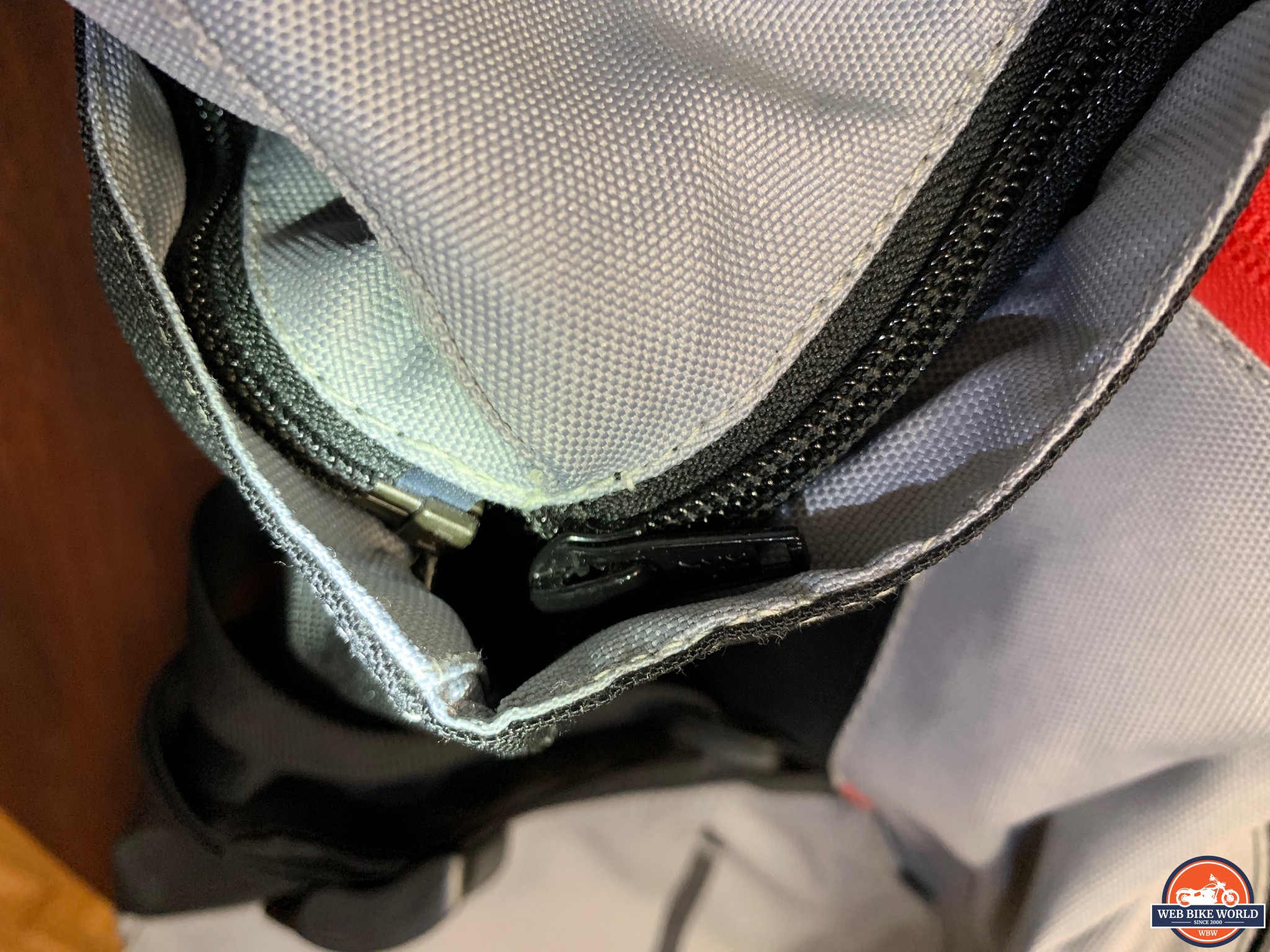
I think if the Riessa layer were a bit longer, it would have prevented so much water from wetting the textile layer. I checked in with Gryphon Moto, and the shorter waterproof layer was deliberately designed shorter to prevent bunching when seated on the bike.
It might be worthwhile to reconsider this feature; a whole day in a heavy rain would likely soak the front of the textile layer and leak through to the rider.
Design and Build Quality
This jacket is designed in the Ontario, Canada area and assembled in Pakistan of materials imported from Korea, Japan and China.
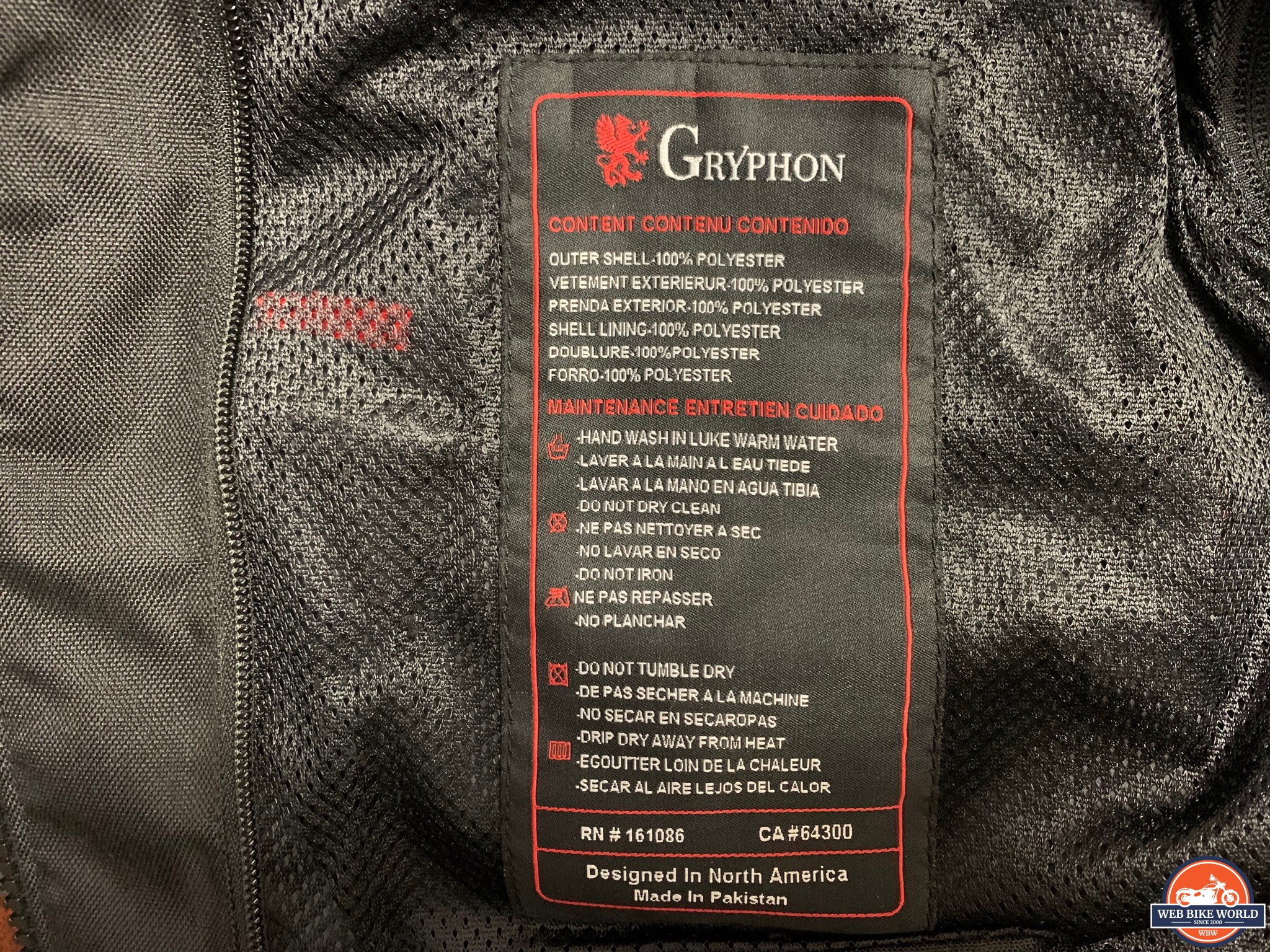
The outer textile layer is sewn of 600 denier “KRYPTONITE” polyester textile; I didn’t see a single dangling or uneven thread anywhere in this garment, although a snap in the rain layer was installed off center that might be a problemwith heavy usage over time.
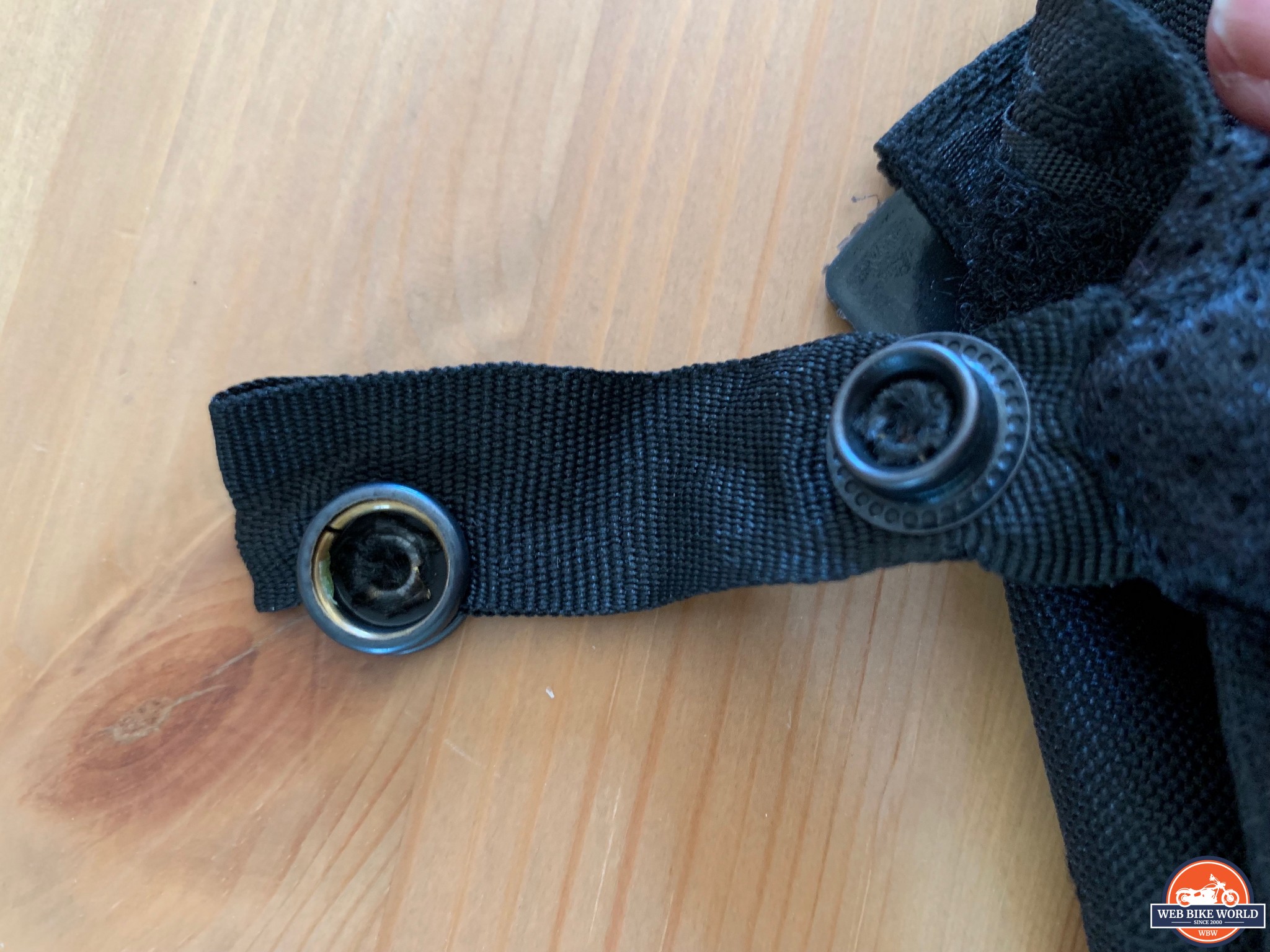
All zippers are YKK, and the H&L fastener strips are thick and very grippy.
All seams are smooth and evenly sewn, with neat hems and stitches. All three layers can be worn independently, with plenty of storage and style; they all have full length zippers, weather flaps and H&L fastening. The outer layer is slightly longer in the back for better weather coverage.
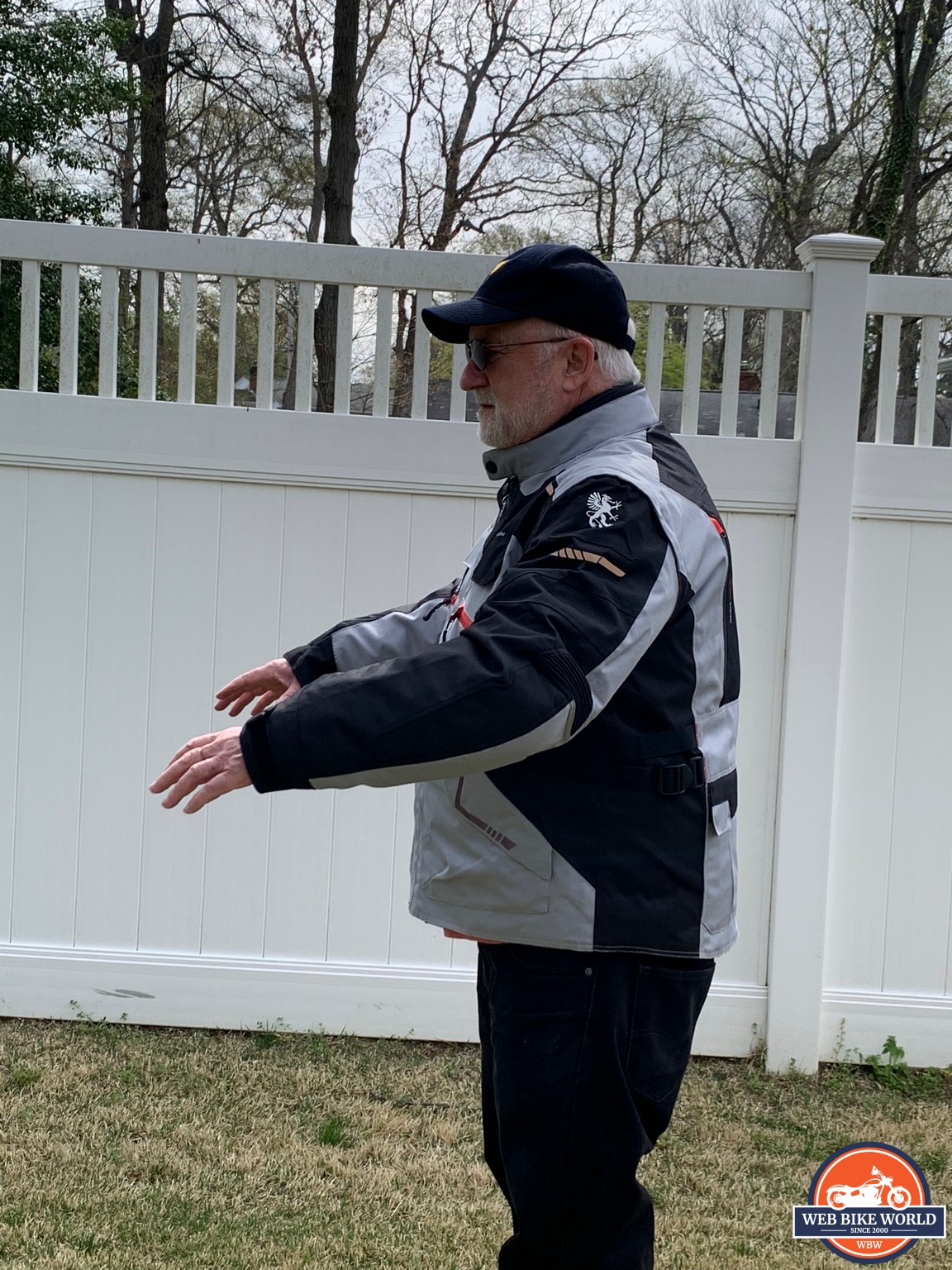
To my eye, the design is outstanding; I particularly like the elegant asymmetrical design of the front, with alternating black and grey panels contrasting with the red zippers. The griffin logo is handsome and visible all overthe jacket.
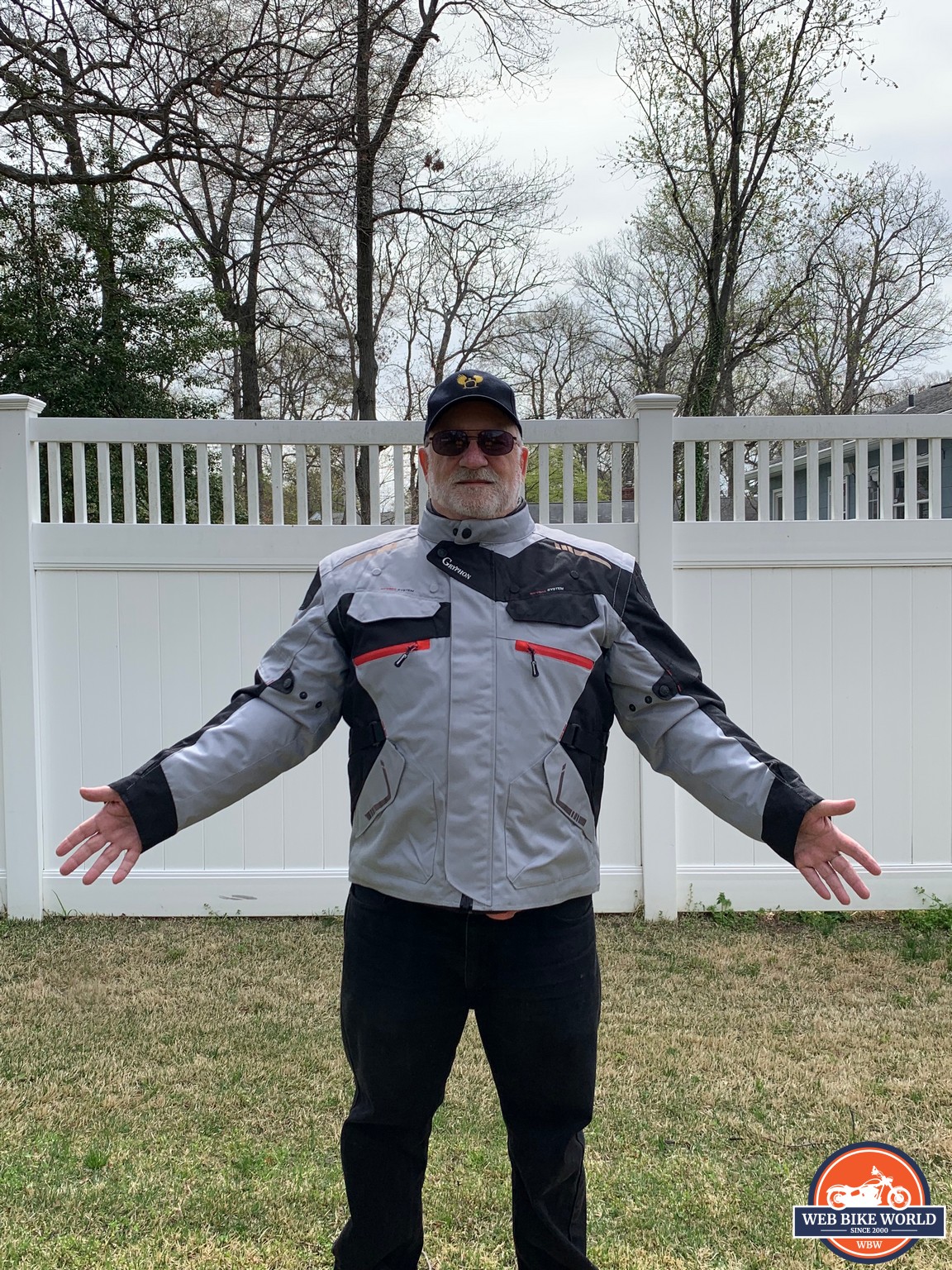
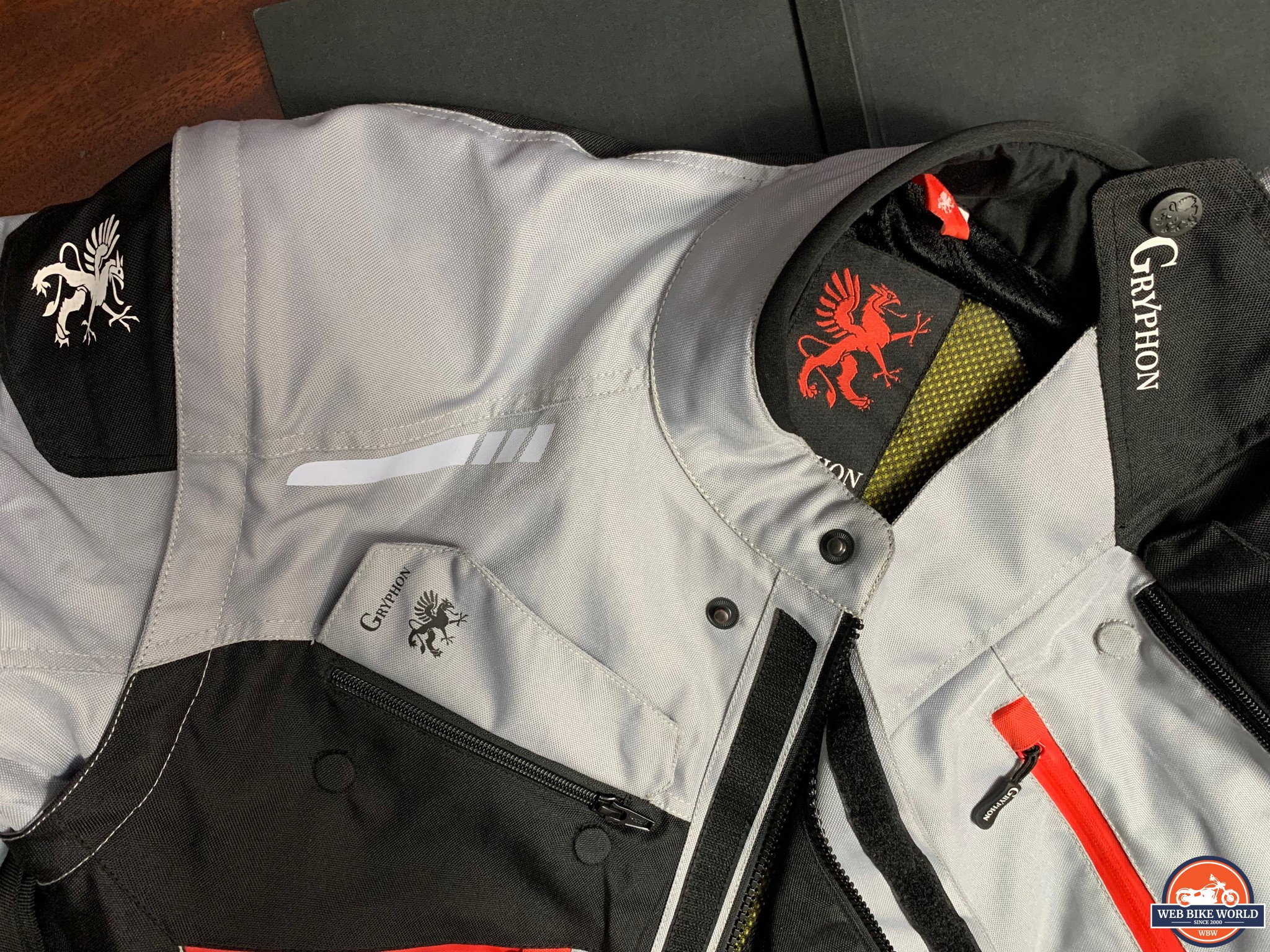
These contrasting style elements would be missing in the all-black Frontier option. Thoughtful features include the key clip, belt loops and zipper panel for securing pants, and waterproof inside phone pockets in two of the layers. That said, a separate rain layer makes for more fiddling and more advance planning than a weatherproof outer layer.
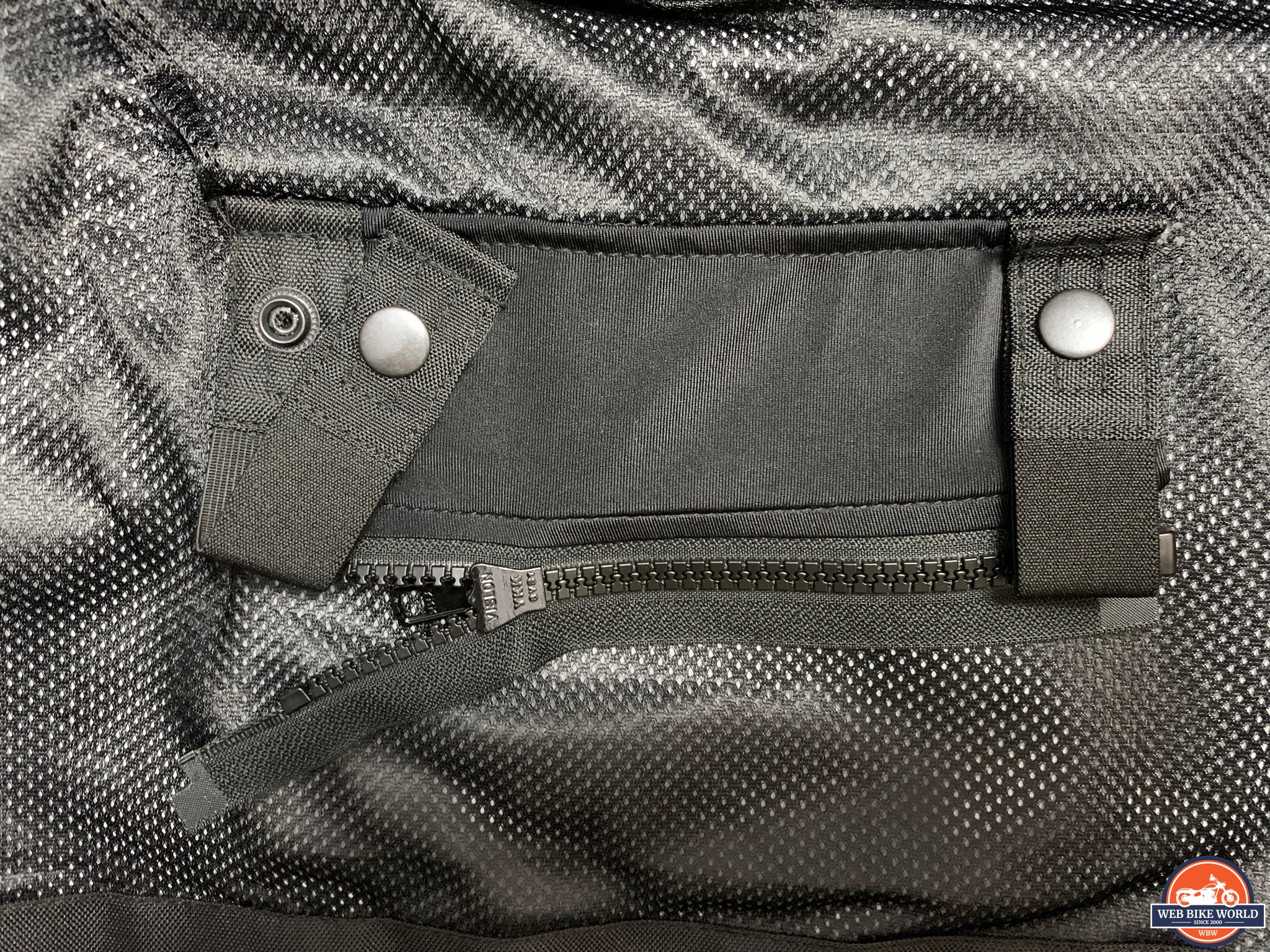
Assembling the three layers into one jacket for the colder months takes time, practice and a little patience. To secure the Riessa waterproof layer inside the outer textile jacket, first the sleeves have to go in. Each sleeve has two fabric loops that are held by snaps on the bottom. Don’t twist and snap the Riessa sleeves on entry, or donning the jacket will be tough.
There’s a loop and snap at the middle of the collar as well, and a zipper on each side to finish up. This two-layer rig should carry into the autumn, with the waterproof layer serving as a windbreaker. Each sleeve of the puffer layer also has two loops for snaps at the bottom of the Riessa layer, and there are two loops and snaps on the soft puffer collar holding it in place. So when all three layers are used, the puffer zipper closes first, followed by the outer textile layer zipper. Lots of loops, snaps and zippers that surely will sort easily with practice.
What will you do for cold mornings in the spring and autumn that have warm afternoons? Maybe skip the puffer holddowns for easy removal.
Airflow/Ventilation
Two horizontal chest vents operate with water resistant zippers, which are covered with magnetic button flaps to hold them up or down.
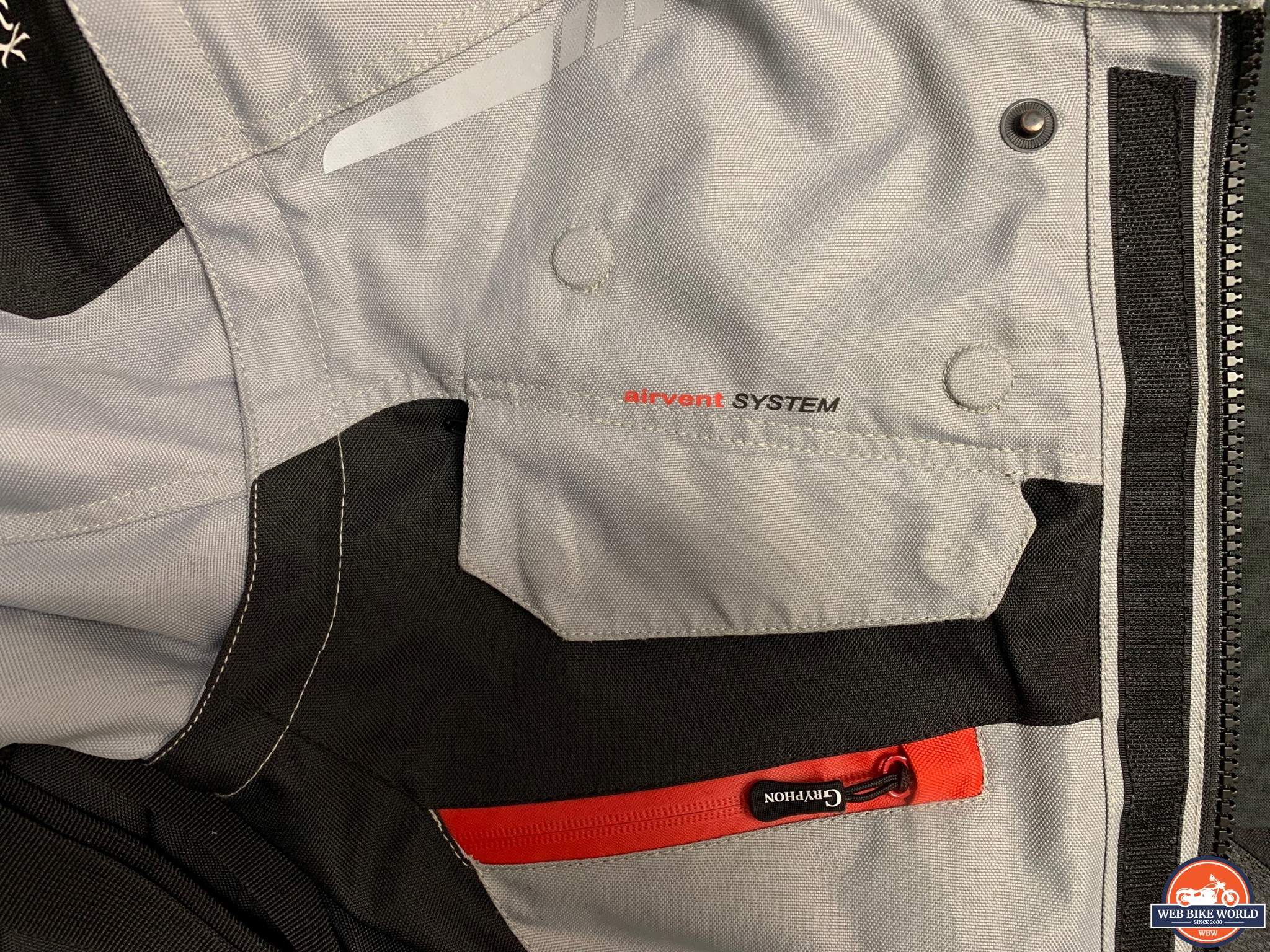
This is a unique feature, especially handy for colder mornings when the flaps go down, and then go up later in the day when the temperature rises. Two vertical vents on the back exhaust the air; that’s the extent of the Frontier’s four-vent system.
However, on hot days the wrist closures can be loosened and the arm zippers can be opened part way for extra air flow. This arrangement worked fine for over 90F, and the looser fit with the puffer and waterproof layers out enhance air movement. All the vents have mesh to prevent unwanted passengers from spoiling the ride.
Protection
This jacket is made of heavy 600 denier polyester textile, and Gryphon has included CE-2 level padding in the elbows, shoulders and back pad.
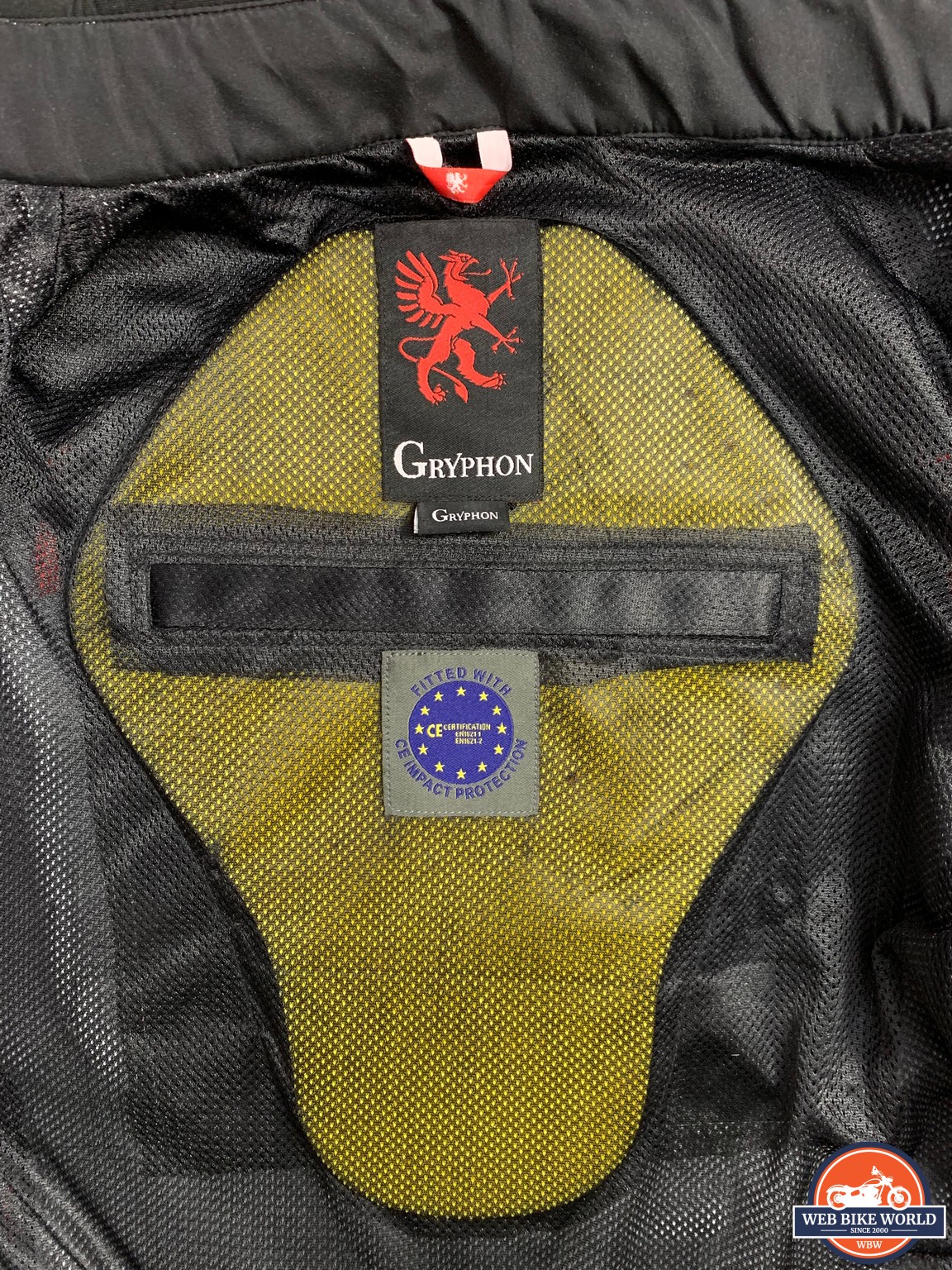
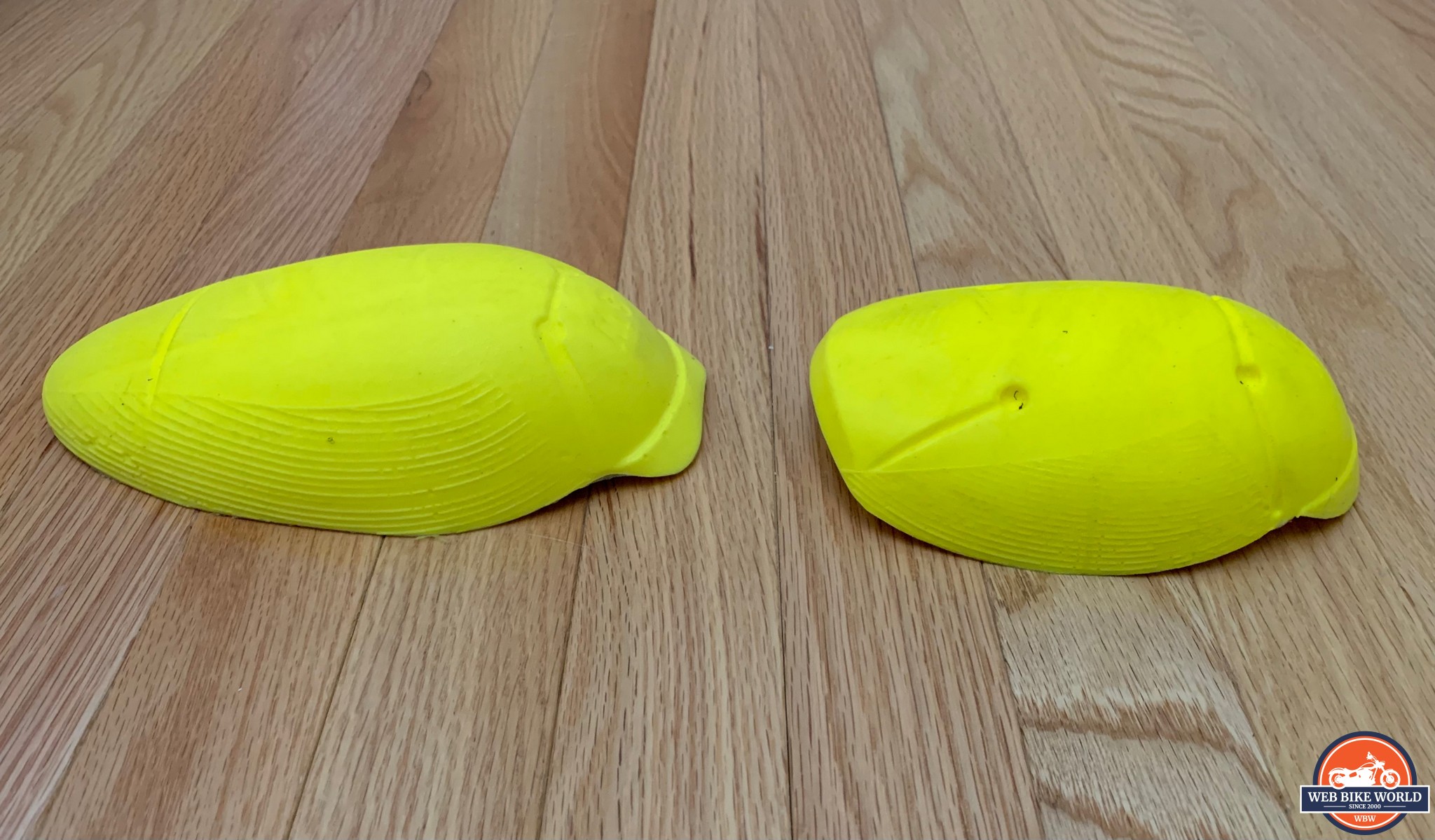
In my experience, this is unusual, if not unique; other mid-level jackets have CE-1 padding in the shoulders and elbows, andoffer an optional back pad. Moreover, the Frontier’s shoulder pads are set in their own H&L mesh pocket, which itself is secured in place with three more beefy H&L patches.
This extra level of padding and included back pad will definitely help in any sort of off, although the lack of a lower arm sizing snap might allow the elbow pad to rotate off the elbow from the loose fit.
My main issue with the Frontier’s level of protection is the zip-off arms. I do occasionally see riders in vests and short sleeves, but removing the sleeves and elbow padding would degrade the Frontier’s otherwise superior protection afforded by the heavy textile fabric and CE-2 padding. Moreover, the arm zippers don’t meet at top and bottom ends, leaving a hole in the underarm only covered by a wind flap.
Finally, there isn’t much reflective material on the textile layer’s front, back or sides, and none on the puffer or Riessa layers (both of which are all black). As a year-round commuter in heavy traffic, I like high visibility.
See related: Gryphon Moto Indy Pant Review
Sizing and Fit
I tend to fall right between XL and XXL with motorcycling gear; it totally depends on the manufacturer and whether a garment is designed with a tighter European fit or a looser North American sizing. I ordered the XXL size Frontier, and the fit is perfect for me. It’s looser when only the textile layer is worn, but the arm snaps and belt tightening system helps.
The single arm snap rides just above the elbow and has three positions; a second one below the elbow might help prevent the hefty CE-2 elbow padding from rolling off in a macadam meeting.
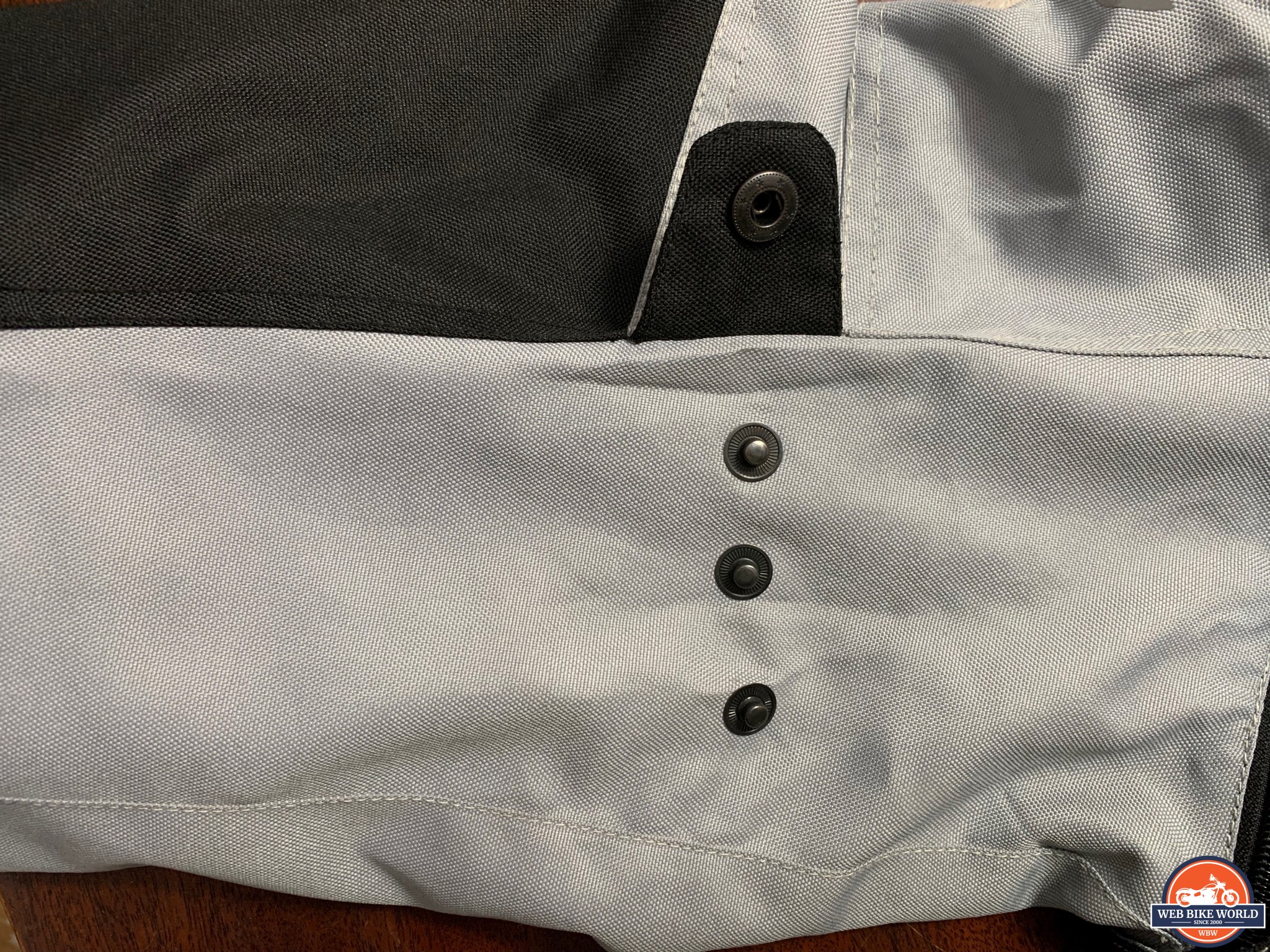
To tighten around the waist, the belt buckles very simply pull back, providing a snug waist adjustment with any combination of layers. Two snaps secure the neck, which is lined with a soft, thin synthetic fabric with a neoprene piping at the top.
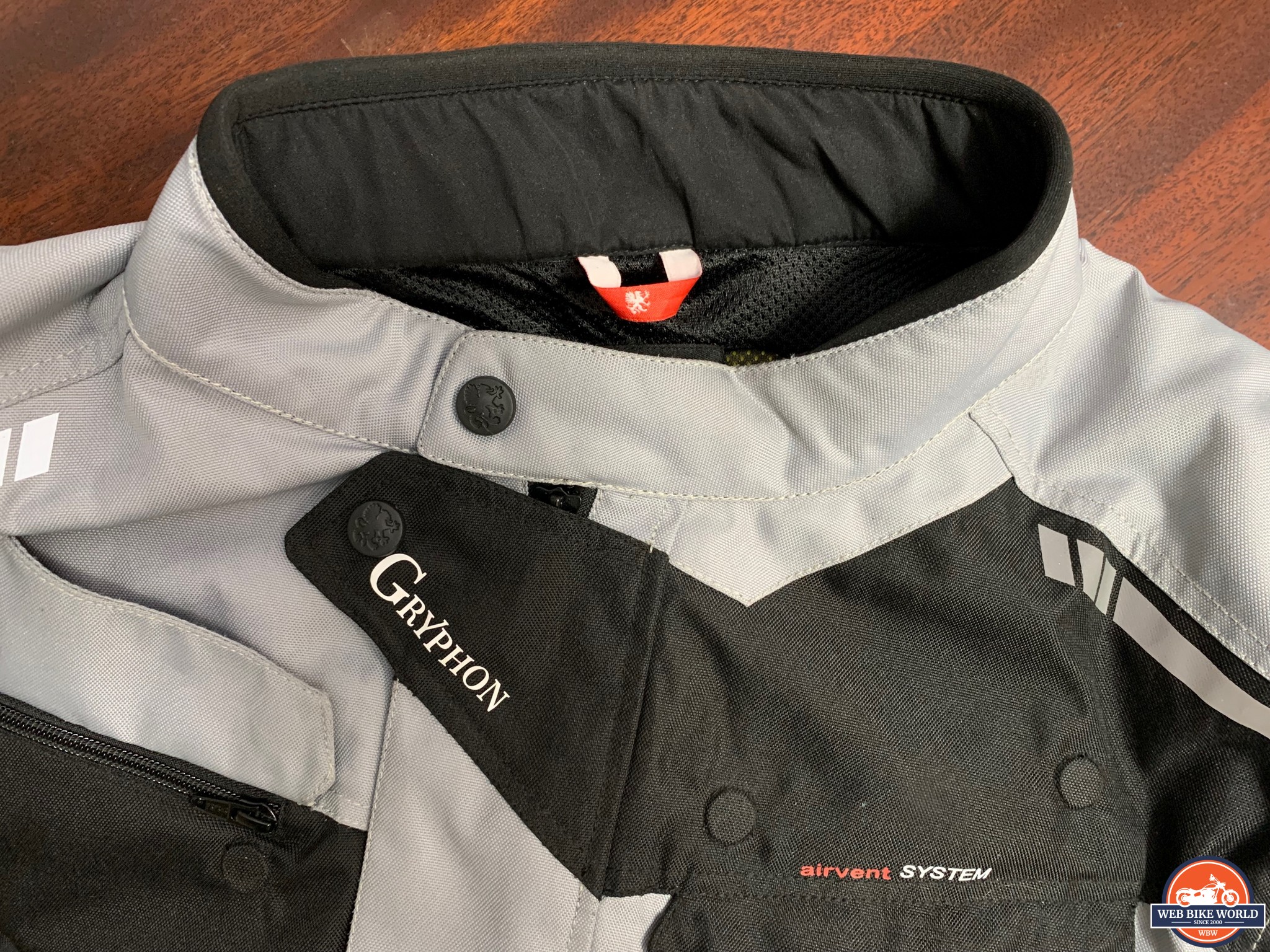
All combinations of layers were comfortable, and a forward arm position and a little extra length for handlebar reach are tailored into the textile layer’s arms for comfort.
Verdict
This is a no-nonsense adult jacket loaded with features in sizes for men and women, for riders who prioritize utility and style over name brand status. Some of us don’t plan to quit our jobs for RTW tours. Sure, there are jackets out there that cost 2-4 times as much as this one, but personally I see little justification for buying them.
This one may not have the name brand status you want, but it has everything you need for year-round use, with a five-year warranty to back it up. I plan to take this jacket on an extended trip this summer to Colorado ghost towns and mountain passes, and I expect it to perform in variable temperatures and weather conditions. That said, I’ll also be taking a waterproof underliner for security. If Gryphon Moto’s Frontier jacket doesn’t meet expectations, I’ll report back and update this review.
Specs
- Manufacturer: Gryphon Moto
- Price (When Tested): $299.95 USD
- Available Colours: Black, Gray & Black
- Sizes: SM, MD, LG, XL, 2XL, 3XL, 4XL
- Review Date: June 2022
Important Links / Where to buy
- Manufacturer Website: Gryphon Moto
- Where to Buy: Gryphon Moto


